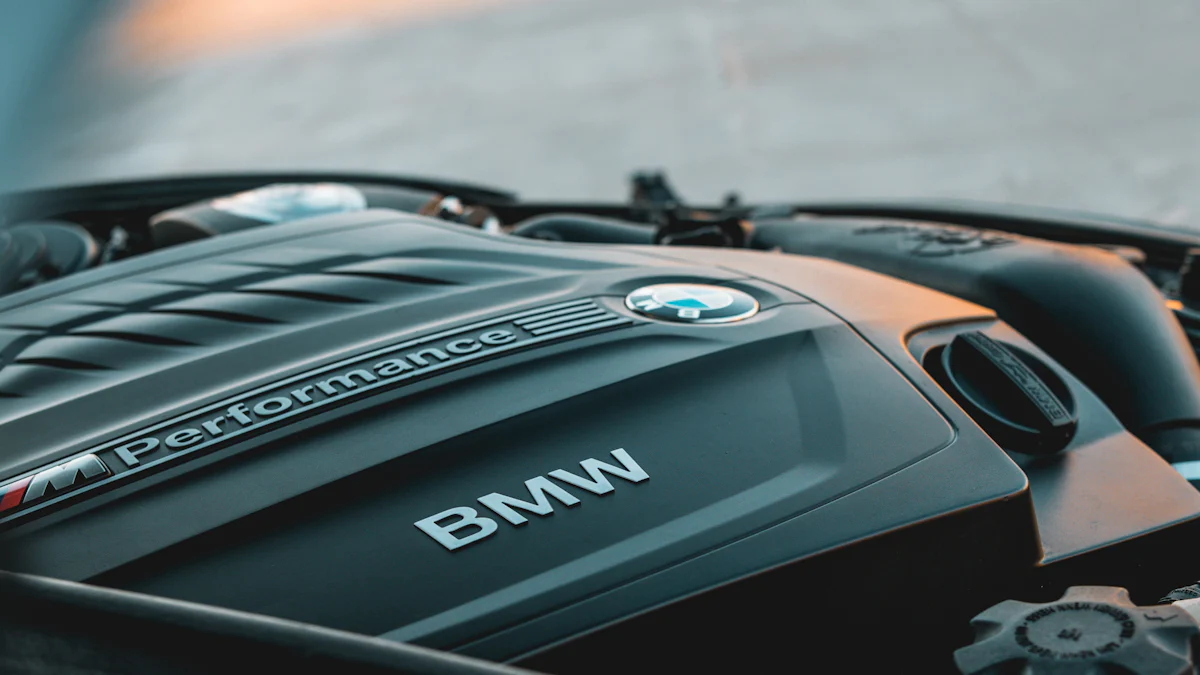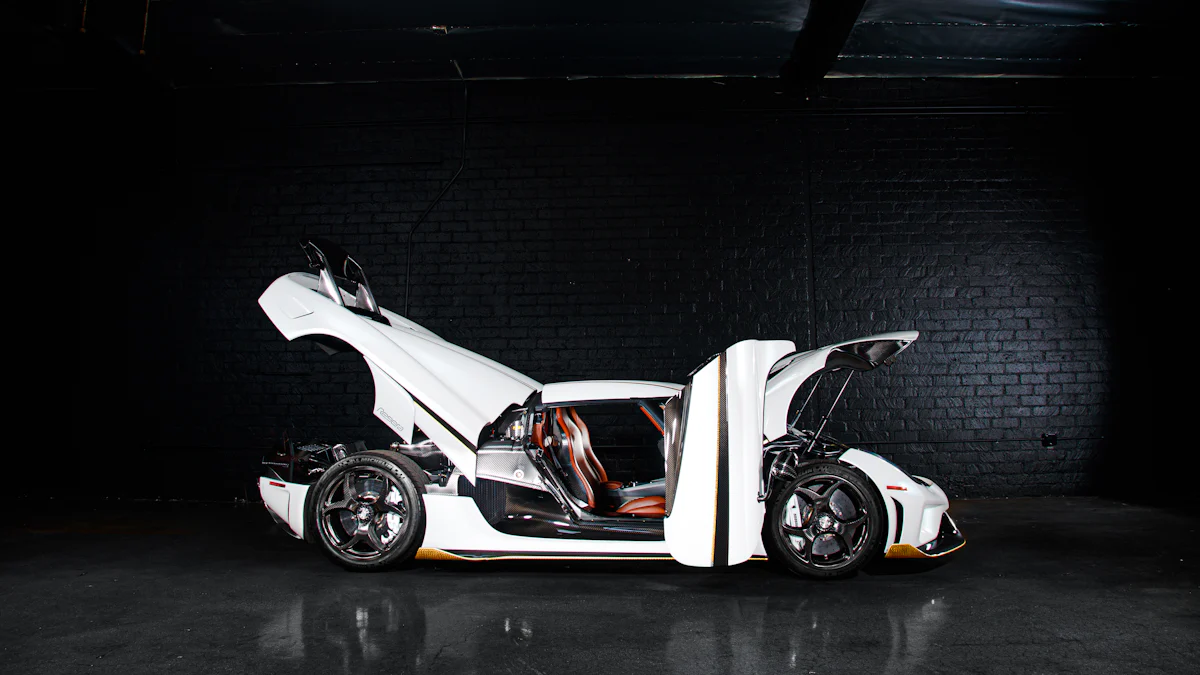The Development of Carbon Fiber in BMW’s Automotive History

Carbon fiber has revolutionized automotive design by offering unmatched strength and lightweight properties. This material reduces vehicle weight by up to 60% compared to steel, significantly improving fuel efficiency and lowering emissions. BMW has emerged as a leader in this innovation, integrating BMW carbon fiber into its production processes to enhance performance and sustainability. The high rigidity of carbon fiber also boosts safety by absorbing impact energy during collisions. Through bold investments and partnerships, BMW continues to redefine the future of automotive engineering with its pioneering use of BMW carbon fiber.
Principales conclusiones
Carbon fiber significantly reduces vehicle weight, improving fuel efficiency and lowering emissions, making it a key material for sustainable automotive design.
BMW’s early adoption of carbon fiber in motorsport demonstrated its potential, leading to innovations that enhanced performance and safety in production vehicles.
The BMW i3 and i8 models showcase how carbon fiber can be integrated into mass-produced vehicles, combining lightweight design with sustainability and performance.
Collaborations, such as with SGL Carbon, have enabled BMW to advance carbon fiber manufacturing, ensuring a reliable supply and reducing production costs.
Carbon fiber’s unique properties enhance vehicle aerodynamics and handling, making it essential for high-performance models like the BMW M series.
BMW’s commitment to sustainability is reflected in its carbon fiber production processes, utilizing renewable energy and innovative manufacturing techniques.
Looking ahead, BMW plans to expand carbon fiber applications across a wider range of vehicles, including electric and autonomous models, reinforcing its leadership in automotive innovation.
BMW’s Early Adoption of Carbon Fiber
The origins of carbon fiber in the automotive industry
Carbon fiber emerged as a groundbreaking material in the mid-20th century, initially developed for aerospace applications. Its unique combination of high strength and low weight quickly attracted attention from other industries, including automotive manufacturing. Early adopters recognized its potential to revolutionize vehicle design by reducing weight without compromising structural integrity. This innovation paved the way for automakers to explore its use in performance-focused and experimental models.
BMW began investigating carbon fiber’s possibilities during this period. The company saw an opportunity to enhance vehicle performance and efficiency by integrating this advanced material into its designs. By leveraging carbon fiber’s properties, BMW aimed to push the boundaries of automotive engineering and set new standards for the industry.
BMW’s initial experiments with carbon fiber in motorsport
Motorsport provided BMW with the perfect testing ground for carbon fiber. The high demands of racing required materials that could withstand extreme conditions while maintaining lightweight construction. In 1999, BMW unveiled the BMW Le Mans V12 LMR, which featured a carbon-fiber-reinforced plastic (CFRP) monocoque chassis. This innovative design contributed to the vehicle’s victory at the 24 Hours of Le Mans, showcasing the material’s potential to enhance both performance and durability.
BMW’s success in motorsport demonstrated the practical benefits of carbon fiber. Engineers used these insights to refine the material’s application in production vehicles. Motorsport not only validated carbon fiber’s capabilities but also highlighted its role in improving aerodynamics, speed, and safety. These early experiments laid the foundation for BMW’s future advancements in carbon fiber technology.
Key milestones in BMW’s early use of carbon fiber
BMW achieved several significant milestones in its early adoption of carbon fiber. The introduction of CFRP components in motorsport vehicles marked the beginning of a new era for the company. Engineers expanded their efforts by incorporating carbon fiber into various parts of high-performance models, such as roofs and body panels. These innovations enhanced vehicle agility and reduced overall weight, improving both handling and fuel efficiency.
The development of the BMW i3 represented another major milestone. This model featured a CFRP passenger cell, known as the LifeDrive architecture, which prioritized weight reduction and safety. By integrating carbon fiber into the vehicle’s structure, BMW maximized interior space and extended the driving range. The i3’s success demonstrated the material’s versatility and its potential to support sustainable urban mobility solutions.
BMW’s early achievements with carbon fiber established the company as a leader in lightweight automotive design. These milestones not only influenced BMW’s future projects but also inspired the broader automotive industry to explore the possibilities of carbon fiber.
The Science Behind BMW Carbon Fiber
Composition and properties of carbon fiber
Carbon fiber stands out as a material with exceptional properties. It consists of thin strands of carbon atoms bonded together in a crystalline structure. This arrangement gives it remarkable strength while maintaining a lightweight profile. Engineers often combine carbon fibers with resin to create carbon-fiber-reinforced plastic (CFRP), which enhances its durability and versatility.
The material’s high strength-to-weight ratio makes it stronger than steel yet significantly lighter. It resists fatigue and corrosion, ensuring longevity even under harsh conditions. Additionally, carbon fiber exhibits excellent rigidity, which improves structural stability. These characteristics make it an ideal choice for automotive applications, where performance and safety are paramount.
Resultados de la investigación científica: Studies highlight that carbon fiber compounds offer low weight, high strength, and resistance to fatigue and corrosion, making them indispensable in modern engineering.
Advantages of carbon fiber in automotive applications
Carbon fiber has transformed automotive design by addressing critical challenges. Its lightweight nature reduces vehicle weight, which directly improves fuel efficiency and lowers emissions. This aligns with the industry’s growing focus on sustainability. By incorporating carbon fiber, automakers can achieve better mileage without compromising performance.
The material also enhances safety. Its ability to absorb and distribute impact forces provides superior crash protection. Furthermore, carbon fiber’s rigidity improves handling and stability, especially in high-performance vehicles. For instance, BMW integrates carbon fiber into its designs to optimize aerodynamics and agility, setting new benchmarks in automotive engineering.
Resultados de la investigación científica: Carbon fiber composites significantly reduce vehicle weight, leading to improved fuel efficiency and enhanced crash protection.
Challenges in manufacturing and cost implications
Despite its advantages, carbon fiber presents challenges in manufacturing. The production process involves energy-intensive steps, such as heating and stretching carbon strands at high temperatures. This complexity increases production costs, making carbon fiber more expensive than traditional materials like steel or aluminum.
Scaling up production for mass-market vehicles remains a hurdle. Automakers must balance the benefits of carbon fiber with its cost implications. BMW addresses this challenge through innovative partnerships, such as its collaboration with SGL Group. By establishing facilities like the one in Moses Lake, Washington, BMW has made strides in reducing costs and increasing production efficiency.
Resultados de la investigación científica: The high cost of manufacturing carbon fiber stems from its energy-intensive production process, which limits its widespread adoption in the automotive industry.
The BMW i Series: A Carbon Fiber Revolution

The BMW i3: Lightweight design and sustainability
En BMW i3 marked a turning point in automotive engineering by showcasing the potential of carbon fiber in mass-produced vehicles. This compact electric car utilized an innovative LifeDrive architecture, which combined a carbon-fiber-reinforced plastic (CFRP) passenger cell with an aluminum chassis. This design reduced the vehicle’s weight significantly while maintaining structural integrity. The i3 weighed 20% less than competitors like the Nissan LEAF, offering improved efficiency and performance.
BMW prioritized sustainability in the i3’s development. The use of CFRP not only enhanced the car’s energy efficiency but also aligned with the company’s commitment to reducing environmental impact. The lightweight structure extended the driving range of the electric motor, making the i3 a practical choice for urban mobility. By integrating carbon fiber into the entire car body, BMW demonstrated how advanced materials could revolutionize everyday vehicles.
Fact: The BMW i3 became the first mass-produced car made largely from carbon fiber, setting a new standard for lightweight and sustainable design.
The BMW i8: Merging performance with innovation
En BMW i8 redefined the concept of a sports car by merging cutting-edge technology with high-performance capabilities. This plug-in hybrid featured a CFRP passenger cell that contributed to its lightweight design and aerodynamic efficiency. The i8’s carbon fiber construction allowed engineers to optimize weight distribution, enhancing handling and agility on the road.
Performance remained a key focus for the i8. The combination of a turbocharged engine and an electric motor delivered impressive acceleration and speed. The use of carbon fiber reinforced the car’s structural rigidity, ensuring safety and stability during high-speed maneuvers. By integrating this advanced material, BMW achieved a balance between sustainability and performance, proving that eco-friendly cars could also deliver thrilling driving experiences.
Highlight: The BMW i8 showcased how carbon fiber could elevate both design and functionality, making it a symbol of innovation in the automotive industry.
Carbon fiber’s role in the i Series’ architecture
Carbon fiber played a central role in the architecture of BMW’s i Series. The material’s exceptional strength-to-weight ratio allowed engineers to create lightweight yet durable structures. In the i3 and i8, CFRP formed the core of the LifeDrive architecture, which separated the passenger cell from the drivetrain. This modular approach improved safety, efficiency, and design flexibility.
The integration of carbon fiber also enhanced the vehicles’ sustainability. By reducing weight, BMW improved energy efficiency and extended the range of electric and hybrid powertrains. The material’s resistance to corrosion and fatigue ensured long-term durability, further supporting the company’s commitment to eco-friendly solutions. The i Series demonstrated how carbon fiber could transform automotive design, paving the way for future innovations.
Información clave: BMW’s use of carbon fiber in the i Series highlighted its potential to redefine vehicle architecture, combining lightweight design with advanced engineering.
BMW Carbon Fiber in High-Performance Models
Integration of carbon fiber in BMW M models
BMW’s M models represent the pinnacle of performance and engineering. The integration of carbon fiber into these vehicles has elevated their capabilities to new heights. Engineers strategically incorporate carbon fiber into key components such as roofs, spoilers, and body panels. This reduces weight while maintaining structural integrity. The lighter construction enhances acceleration, braking, and cornering, which are critical for high-performance driving.
For example, the BMW M2 Competition demonstrates the transformative impact of carbon fiber. Models equipped with carbon fiber body panels weigh significantly less than those with traditional steel panels. This weight reduction improves agility and responsiveness, offering a more dynamic driving experience. By using carbon fiber, BMW ensures that its M models deliver unmatched performance on both the road and the track.
Fact: The BMW M4 GT4 incorporates sustainable composite solutions, including natural fiber composite parts, showcasing BMW’s commitment to innovation and environmental responsibility.
Enhancing aerodynamics and speed with carbon fiber
Aerodynamics play a crucial role in high-performance vehicles, and carbon fiber contributes significantly to this aspect. Its lightweight nature allows designers to create complex shapes that optimize airflow. In BMW M models, carbon fiber components such as splitters, diffusers, and rear wings reduce drag and increase downforce. This improves stability at high speeds and enhances overall efficiency.
En BMW M4 GT4 exemplifies how carbon fiber enhances aerodynamics. Engineers use carbon fiber to craft aerodynamic elements that improve handling and speed. These features allow the car to maintain better grip during sharp turns and achieve higher top speeds. By leveraging carbon fiber’s properties, BMW maximizes the performance potential of its M models.
Highlight: Carbon fiber’s ability to combine lightweight construction with aerodynamic efficiency makes it an indispensable material in BMW’s high-performance lineup.
Examples of M models featuring carbon fiber components
Several BMW M models showcase the extensive use of carbon fiber. The BMW M2 Competition stands out with its carbon fiber roof and body panels. These components reduce the car’s center of gravity, improving balance and handling. Drivers benefit from enhanced control, especially during aggressive maneuvers.
En BMW M4 GT4 takes carbon fiber integration a step further. It features natural fiber composite parts, which offer similar benefits to traditional carbon fiber while promoting sustainability. This innovative approach highlights BMW’s dedication to pushing the boundaries of material science.
Other M models, such as the BMW M5 y BMW M8, also incorporate carbon fiber in various elements. From interior trims to exterior accents, these components enhance both aesthetics and performance. BMW’s use of carbon fiber in its M models underscores its commitment to delivering cutting-edge technology and unparalleled driving experiences.
Información clave: BMW’s strategic use of carbon fiber in its M models not only improves performance but also sets a benchmark for innovation in the automotive industry.
BMW’s Carbon Fiber Manufacturing Innovations

The partnership with SGL Carbon and its significance
BMW’s collaboration with SGL Carbon marked a pivotal moment in the development of carbon fiber technology. The two companies formed a joint venture, SGL Automotive Carbon Fibers (SGL ACF), to advance the production of carbon-fiber-reinforced plastic (CFRP). This partnership allowed BMW to secure a reliable supply of high-quality carbon fiber for its vehicles, particularly the BMW i series.
The joint venture focused on creating lightweight components that could enhance vehicle performance and efficiency. By pooling resources and expertise, BMW and SGL Carbon accelerated the development of innovative manufacturing techniques. This collaboration also ensured that BMW maintained a competitive edge in the automotive industry by integrating cutting-edge materials into its designs.
Información clave: The partnership with SGL Carbon enabled BMW to pioneer the use of CFRP in mass-produced vehicles, setting a new standard for lightweight automotive design.
The Moses Lake facility and mass production breakthroughs
The Moses Lake facility in Washington became a cornerstone of BMW’s carbon fiber strategy. Operated by SGL ACF, this state-of-the-art plant specialized in producing carbon fibers for BMW’s vehicles. The facility utilized clean hydroelectric power, ensuring an environmentally friendly production process. This commitment to sustainability aligned with BMW’s broader goals of reducing its environmental footprint.
The Moses Lake plant achieved significant breakthroughs in mass production. Engineers developed efficient methods to produce carbon fibers at scale, making it feasible to incorporate CFRP into high-volume models like the BMW i3 y BMW i8. The facility’s advanced technology allowed BMW to overcome traditional challenges associated with carbon fiber manufacturing, such as high costs and energy consumption.
Fact: The Moses Lake facility exclusively used renewable energy, demonstrating BMW’s dedication to sustainable manufacturing practices.
Sustainability in BMW’s carbon fiber production process
BMW prioritized sustainability throughout its carbon fiber production process. The company leveraged renewable energy sources, such as hydroelectric power, to minimize the environmental impact of its operations. This approach not only reduced carbon emissions but also set a benchmark for eco-friendly manufacturing in the automotive industry.
The use of CFRP in vehicles like the BMW i3 y BMW i8 further supported BMW’s sustainability goals. By reducing vehicle weight, carbon fiber improved energy efficiency and extended the range of electric and hybrid powertrains. These advancements underscored BMW’s commitment to creating innovative solutions that balanced performance with environmental responsibility.
Highlight: BMW’s sustainable approach to carbon fiber production reinforced its position as a leader in eco-friendly automotive innovation.
The Influence of Carbon Fiber on BMW’s Design Philosophy
Redefining aesthetics and performance with carbon fiber
BMW has redefined automotive aesthetics and performance by integrating carbon fiber into its vehicle designs. This material allows designers to create sleek, aerodynamic shapes that enhance both visual appeal and functionality. Carbon fiber’s lightweight nature enables engineers to reduce vehicle weight without compromising structural integrity. This combination of form and function has become a hallmark of BMW’s design philosophy.
The use of carbon fiber in visible components, such as roofs and body panels, adds a distinctive, high-tech appearance to BMW models. For instance, the carbon fiber roofs in BMW M models not only improve aerodynamics but also lower the center of gravity, enhancing handling and stability. These features demonstrate how BMW blends cutting-edge materials with innovative design to deliver vehicles that excel in both performance and style.
Información clave: BMW’s strategic use of carbon fiber showcases its commitment to pushing the boundaries of automotive design, creating vehicles that are both visually striking and mechanically superior.
Balancing innovation, sustainability, and functionality
BMW’s approach to carbon fiber reflects a careful balance between innovation, sustainability, and functionality. By incorporating carbon fiber into its designs, BMW addresses the growing demand for eco-friendly solutions in the automotive industry. The material’s lightweight properties contribute to improved fuel efficiency and reduced emissions, aligning with BMW’s sustainability goals.
The company also prioritizes functionality. Carbon fiber’s high strength-to-weight ratio ensures durability and safety, even under demanding conditions. This focus on practicality allows BMW to integrate carbon fiber into a wide range of models, from high-performance sports cars to electric vehicles. The result is a lineup of vehicles that meet diverse consumer needs while maintaining a commitment to environmental responsibility.
Fact: BMW’s use of carbon fiber in the i Series highlights its ability to combine sustainability with advanced engineering, setting a new standard for eco-friendly automotive design.
Carbon fiber’s integration into future BMW concepts
BMW continues to explore the potential of carbon fiber in shaping the future of automotive design. The material’s versatility makes it an ideal choice for upcoming models, including electric and autonomous vehicles. Engineers are investigating new ways to incorporate carbon fiber into vehicle architectures, focusing on enhancing efficiency, safety, and performance.
Future BMW concepts may feature even more extensive use of carbon fiber, from structural components to interior elements. This integration will likely redefine vehicle design, offering greater flexibility and innovation. By leveraging carbon fiber’s unique properties, BMW aims to create vehicles that not only meet but exceed the expectations of modern drivers.
Highlight: BMW’s ongoing investment in carbon fiber technology underscores its vision for the future, where lightweight materials play a central role in advancing automotive innovation.
The Future of BMW Carbon Fiber Technology
Advancements in carbon fiber materials and techniques
BMW continues to lead advancements in carbon fiber technology, pushing the boundaries of material science. Engineers are exploring innovative carbon fiber composites that incorporate nanotechnology to enhance strength, flexibility, and durability. These advancements aim to create lighter and stronger materials, which can withstand greater stress while maintaining their structural integrity. By refining production processes, BMW has also improved the efficiency of carbon fiber manufacturing. The Landshut plant, for instance, has optimized cycle times and automated tooling solutions, enabling cost-effective mass production of carbon-fiber-reinforced plastic (CFRP) components.
The company’s research focuses on developing carbon fiber materials with enhanced functionality. These materials promise to revolutionize automotive design by offering improved performance capabilities. BMW envisions a future where entire vehicle bodies could be constructed from carbon fiber, significantly reducing weight and improving fuel efficiency. This vision aligns with the growing demand for sustainable and efficient vehicles, ensuring that BMW remains at the forefront of automotive innovation.
Resultados de la investigación científica: Advancements in carbon fiber composites, driven by materials science and nanotechnology, are shaping the future of automotive design, enabling lighter and more intelligent vehicles.
Upcoming BMW models featuring carbon fiber
BMW plans to expand the use of carbon fiber across its upcoming vehicle lineup. The integration of this material will not be limited to high-performance or luxury models. Instead, BMW aims to make carbon fiber more accessible by incorporating it into a broader range of vehicles. This strategy reflects the company’s commitment to democratizing advanced materials and ensuring that more drivers can benefit from their advantages.
Future models will likely feature carbon fiber in both structural and aesthetic components. Lightweight roofs, body panels, and interior trims will enhance performance and efficiency while maintaining BMW’s signature design philosophy. The company’s expertise in CFRP-specific production processes ensures that these components meet high-quality standards. By integrating carbon fiber into everyday vehicles, BMW is setting a new benchmark for innovation and accessibility in the automotive industry.
Información clave: BMW’s breakthroughs in large-scale CFRP production challenge the notion that carbon fiber is exclusive to niche applications, paving the way for its use in a wider range of vehicles.
The role of carbon fiber in electric and autonomous vehicles
Carbon fiber plays a crucial role in the development of electric and autonomous vehicles. Its lightweight properties directly address the challenges of battery efficiency and range in electric cars. By reducing vehicle weight, carbon fiber allows engineers to extend driving ranges without compromising performance. This makes it an essential material for the next generation of electric vehicles, where efficiency and sustainability are paramount.
In autonomous vehicles, carbon fiber contributes to both safety and design flexibility. The material’s high strength-to-weight ratio enhances crash protection, ensuring passenger safety in self-driving cars. Additionally, its versatility allows designers to create innovative vehicle architectures that accommodate advanced technologies, such as sensors and cameras. BMW’s ongoing research into carbon fiber integration underscores its commitment to shaping the future of mobility.
Highlight: BMW’s vision for carbon fiber includes its pivotal role in electric and autonomous vehicles, where lightweight design and advanced engineering intersect to redefine transportation.
BMW’s journey with carbon fiber showcases its commitment to innovation and excellence. From early experiments in motorsport to groundbreaking advancements in mass production, BMW has consistently pushed the boundaries of automotive engineering. The integration of carbon fiber has redefined vehicle performance, efficiency, and sustainability, setting new industry standards.
“Carbon fibers will become the key automotive material in the future,” stated BMW CEO Norbert Reithofer, reflecting the company’s vision.
Looking ahead, BMW aims to expand carbon fiber applications across diverse models, including electric and autonomous vehicles. This forward-thinking approach ensures that BMW remains a leader in shaping the future of mobility.
